我正在尝试设置我的 JavaFX 折线图的样式,但我在图例方面遇到了一些麻烦。
我知道如何更改 css 文件中折线图的图例颜色:
.default-color0.chart-series-line { -fx-stroke: #FF0000, white; }
.default-color1.chart-series-line { -fx-stroke: #00FF00, white; }
.default-color2.chart-series-line { -fx-stroke: #0000FF, white; }
.default-color0.chart-line-symbol { -fx-background-color: #FF0000, white; }
.default-color1.chart-line-symbol { -fx-background-color: #00FF00, white; }
.default-color2.chart-line-symbol { -fx-background-color: #0000FF, white; }
但这对我的目的来说还不够。我有三个或更多彩色切换按钮和每个按钮的一系列数据。选择按钮后,数据应以与按钮相同的颜色显示。这应该可以通过多选按钮来实现,以便可以同时显示多个系列的数据。
对于图表线,我在单击按钮后通过更改样式来管理它:
..
dataList.add(series);
..
series.getNode().setStyle("-fx-stroke: rgba(" + rgba + ")");
如果我取消选择按钮,我会从列表中删除数据。
dataList.remove(series);
这对于笔画来说效果很好,但我怎样才能为图例做同样的事情呢?
您可以在下面看到一个示例。首先我点击了红色按钮,因此笔触和图例是红色的(默认颜色 0)。之后,我单击了蓝色按钮。在这里你可以看到问题。笔划是蓝色的,但图例是绿色的,因为使用了默认颜色 1,我不知道如何更改图例颜色。
